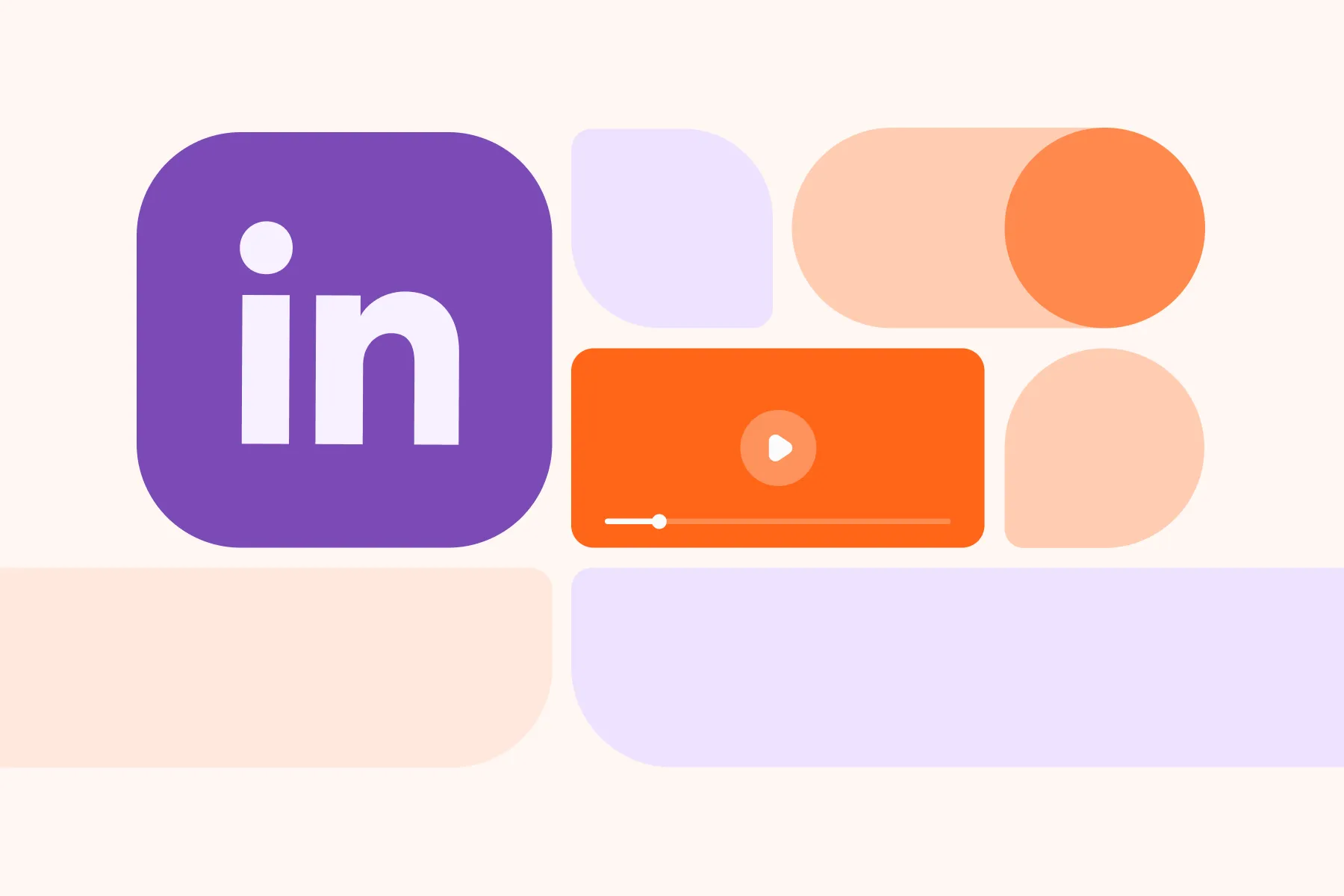LinkedIn Video Ads for B2B SaaS: Creative Strategies That Generate Enterprise Leads
Anastasiya Khvin
October 14, 2025

Most B2B video ads on LinkedIn are forgettable.
You've probably seen them. Generic "we help companies do X" intros. Stock footage of people nodding in conference rooms. Voiceovers that could work for any software company.
When we dig into campaigns that actually generate enterprise leads (the kind that turn into six-figure deals), there's a pattern. These winning LinkedIn video ad campaigns understand something fundamental, video ads on LinkedIn aren't just YouTube ads wearing a suit.
At Aimers, we've helped companies like Mixpanel and ShipBob crack the code on B2B video advertising. Check out more success stories across our case studies.
LinkedIn Video Ads Actually Outperform Everything Else in B2B
We ran a campaign comparison for a client in the analytics space. Same budget, same targeting, split between static images and video content.
The LinkedIn videos generated 3.2x more conversions.
But what really got us: the leads from video ad campaigns had a 47% higher close rate. Not just more leads.Better leads.
Why? LinkedIn video ads build trust at scale. Enterprise buyers aren't clicking "buy now" after one ad; they're researching your company culture, expertise, and approach. According to Gartner research, the typical B2B buying journey now involves 6-10 decision-makers and up to 27 individual interactions. Video accelerates this entire process.
In 30 seconds, you can communicate positioning, demonstrate thought leadership, and show how your software works. Plus, video content in the LinkedIn feed gets algorithmic preference. We've seen organic reach on video posts 5x higher than image ads. When you sponsor that video? You're combining paid targeting precision with organic amplification. It's like getting two channels for the price of one, honestly, it's one of the few things in B2B marketing that actually over-delivers on its promise.
Technical Specs That Make or Break Your Campaign
This part isn't sexy. But mess up your LinkedIn video ad specs and you're basically flushing budget down the drain.
We've audited too many campaigns where companies spent thousands on video production only to have creative butchered by wrong aspect ratios or file size issues. It hurts to see, kind of like watching someone order an expensive steak well-done.
Getting Your Video Specifications Right
What actually matters (and what LinkedIn's documentation doesn't emphasize enough):
.webp)
Wistia's video engagement research confirms that engagement drops significantly after 2 minutes for marketing videos.
Aspect Ratios Are More Important Than You Think
LinkedIn supports three aspect ratios for video ad placements:
.webp)
We rarely use for B2B. Desktop drives 68% of conversions; vertical looks awkward
For more detailed guidance on LinkedIn video specifications and creative approaches, check out our guide on LinkedIn video ad examples and best practices. You can also reference LinkedIn's official video ad specifications for the latest technical requirements.
Feed Placement vs. Audience Network (Spoiler: Choose Feed)
Quick decision tree for you.
If you're doing lead gen with forms, keep it in the LinkedIn feed only. Turn off LinkedIn Audience Network placement. Yes, you'll reach fewer people, but the audience quality difference is night and day.
LinkedIn Audience Network extends your ads to third-party apps and websites. Great for brand awareness where you want maximum impressions. Terrible for enterprise lead generation.
We ran a test with a B2B marketing automation client. Same creative, same budget. Feed-only campaigns generated leads at $142 per lead. When we enabled Audience Network, CPL dropped to $67, but the sales team couldn't get a single one on a call. They were junk leads.
Keep your LinkedIn ads for software in the feed.Period.
Building Your Foundation Before You Shoot a Single Frame
Before creative concepts or Campaign Manager settings, get strategic about how video fits into your go-to-market motion. Most companies skip ahead and wonder why their campaigns underperform, it's like trying to build a house starting with the roof.
Match Your Video to the Buyer's Journey (Not Your Sales Pitch)
Enterprise sales isn't linear, but there are definite stages where the right message moves things forward.
Problem awareness stage. Video content should focus on the pain point, not your product. We created a campaign for a supply chain software company that showed cascading failures from inaccurate inventory data. Never mentioned their product. Generated 1,200+ video views from target accounts in two weeks.Thirty-four accounts ended up in sales conversations within 90 days.
You know what made it work? It felt like they were reading the viewer's mind.
Solution exploration stage. Thought leadership video ad examples shine here. Your CEO breaking down a framework for thinking about the problem.
Vendor evaluation stage. Product demos and customer testimonials. But keep them short; no one's watching a 5-minute product walkthrough in their LinkedIn feed. Save that for your website. In paid ads, go with 20-second "trailer" style demos that create curiosity.
The Nine-Month Sales Cycle Problem
One retail tech client had a nine-month sales cycle.
Nine months!
Their initial approach was mini webinars, educational, sure, but way too much too soon. We restructured their entire strategy around micro-commitments. First touch: 15-second video about a pain point, no CTA. Second touch: 20-second video with a stat and soft CTA. Third touch: testimonial video, 25 seconds, demo CTA.
Treating LinkedIn video ads like chapters in a story, not standalone sales pitches. Each video built on the last. We used LinkedIn's matched audiences to create sequential campaigns that only showed video 2 to people who watched 75%+ of video 1.
Their pipeline from LinkedIn went from $2.1M to $7.8M in six months. Not because any single video was revolutionary, because the strategy acknowledged how actual humans make enterprise software decisions.
Creative That Stops the Scroll
Let's talk about the actual creative. Most companies either overthink it or phone it in; there's rarely middle ground.
The Silent Video Problem Nobody Wants to Admit
85% of LinkedIn video views happen without sound.
Read that again.
85%.
Your beautifully scripted voiceover? Most people aren't hearing it. That perfectly selected background music? Wasted. This is why the first 3 seconds of your video need to work visually, with or without audio.
According to Digiday's research on social video consumption, up to 85% of video views on social platforms happen with sound off. This isn't just a LinkedIn phenomenon, it's how people consume social media at work, on public transport, or in any situation where playing audio would be disruptive.
Scroll-Stop Patterns That Actually Work:
- Provocative stat on screen - "73% of [target persona] admit they're using [outdated solution]" in bold text. Creates immediate relevance.
- Before/after visual - Show a messy dashboard, then snap to the clean version. The visual contrast tells a story. No audio needed.
- Breaking the fourth wall - Someone looking at camera with text: "If you're a [job title] watching this..." It feels personal.
For captions, use LinkedIn's built-in captioning and always edit them. Nothing screams "we didn't care enough to QC this" like caption errors.
Education vs. Product Marketing Is a False Choice
There's this false dichotomy in B2B video marketing, "educational content" versus "product marketing." Like you have to pick one.
The campaigns that generate actual enterprise leads blur this line entirely.
We worked with a cybersecurity SaaS company. Their CISO did a 20-second video: "The average ransomware attack takes 21 days to detect. By then, your data's already gone. That's not a security problem. That's an architecture problem." Final 5 seconds showed their dashboard with caption: "Real-time threat detection that spots attacks in under 90 seconds."
That's thought leadership AND product marketing.
Compare that to most product demo videos: "Our platform helps companies secure their data with AI-powered monitoring..."
Yawn. Next.
The best B2B SaaS video advertising doesn't feel like advertising. HubSpot's research on B2B content preferences consistently shows that buyers prefer educational content over promotional material, even when they're actively in buying mode.
LinkedIn's Format Options (Most People Don't Even Know About)
LinkedIn offers several video ad formats beyond basic sponsored video:
Video ads with website visits objective, standard option for driving traffic to landing pages.
Video ads with lead gen forms, our go-to for enterprise lead generation LinkedIn campaigns. The friction is zero. We've seen conversion rates 3-4x higher than sending people to landing pages.
Conversation ads with video, sneaky good but underused. Include a 15-second video inside LinkedIn message ads. Feels way more personal.
Thought leader ads, let executives post video organically, then boost it. More trust, better engagement.
Targeting That Actually Works
You can have the best creative in the world. But if you're showing it to the wrong people, you're just burning money.
LinkedIn's targeting gets complicated, honestly, unnecessarily complicated sometimes.
Start With Companies, Not Job Titles
LinkedIn's Campaign Manager interface is not intuitive. It's powerful but clunky. Setting up targeting for campaigns focused on enterprise accounts, this is going to sound counterintuitive if you're coming from Google Ads or Facebook.
Start with company targeting, not job titles.
On LinkedIn, upload a list of company names (your ICP, target accounts from Salesforce, competitor's customers) and target anyone who works there. We combine company lists with seniority filtering (Director+, VP+, C-level) and specific job functions.
This is core to our LinkedIn Ads service. When Mixpanel came to us struggling with lead volume, we shifted from broad job title targeting to company-list targeting. They managed to increase leads substantially while driving down CPL.
Our team put together 5 expert tips for LinkedIn ads best practices that cover audience testing and optimization.
Layer on matched audiences. Upload email lists of churned customers or trials that didn't convert. Run video campaigns to people who already know your brand. You know what? Sometimes the best prospects are the ones who already said no once. Timing matters.
Exclude current customers. Sounds obvious, but you'd be surprised.
Geographic targeting matters more than you think. If your sales team only handles North America, don't target Europe just because you technically can sell there.
Lead Gen Forms Done Right
LinkedIn's lead gen forms are probably the single best feature of the platform for B2B SaaS. But there's a right way and a wrong way to use them.
Keep forms short. LinkedIn auto-fills name, email, job title, company, don't ask for this again. Add max 2-3 custom questions. Make them optional if possible. Every additional field drops conversion rate by 10-15%. Unbounce's conversion benchmark data shows that form length is one of the most significant factors affecting conversion rates across industries.
The thank-you page is where the magic happens. After submission, LinkedIn shows a thank-you page with a CTA button. Send them to your most compelling next step, video explainer or interactive product tour. Not "thanks, we'll be in touch." You've got their attention right now; use it.
Even the best ad campaign can't save a broken landing page or bad analytics. We see this all the time, companies spending thousands on LinkedIn ads, getting clicks, but then sending people to generic landing pages that weren't built for the campaign.
That's why we pair video ad campaigns with dedicated landing page design and conversion rate optimization. When ShipBob came to us, we rebuilt their entire conversion path. The result was an increase in both lead volume and quality, plus a significant jump in conversion rates across their top campaign groups.
Integrate with your CRM immediately using Zapier or native integrations. Speed-to-lead matters, companies responding within 5 minutes convert at 9x the rate of those who wait an hour.
Funnel-Stage Content Strategy
Not all videos should do the same job. Sounds obvious, but most companies create one video and try to use it everywhere. That's like using a screwdriver when you need a hammer.
Top of Funnel Shouldn't Feel Like Advertising
Top-of-funnel video content has one job: make your brand memorable to people not yet in-market.
The mistake most SaaS companies make is trying to educate too much or sell too early. Brand awareness content should be almost entertaining. Provocative. Worth sharing. At this stage, you're not trying to close deals. You're trying to plant seeds.
We created a campaign for a fintech company that didn't mention their product. Just a 20-second video showing a finance team realizing they'd been calculating runway wrong, just pure relatable pain. Text overlay: "Bad math is expensive." Last frame: their logo.
No CTA. No demo request. Nothing.
That video got 180,000 video views and was shared organically by CFOs across LinkedIn. Brand awareness campaigns shouldn't be measured by leads generated this week; they're measured by whether your brand is in the consideration set when people enter the market six months from now.
Bottom of Funnel Gets Direct
Mid-to-bottom funnel is where you get more direct. These people know they need a solution; they're evaluating options; they're ready to talk to someone.
Your video creative here should clearly state who the product is for. Show it in action (even briefly). Have an obvious, strong CTA.
"See how [competitor X customers] are migrating to [your product]" works better than generic "schedule a demo."
One framework: problem-agitation-solution in 25 seconds. 0-8 seconds: show the problem. 8-17 seconds: make it worse. 17-25 seconds: show your solution handling it.
When we helped Originality.AI, we focused on this structure. We increased their Google Ads sales by 100%, but the LinkedIn video ad campaigns using this framework performed even better.
Retargeting Is About Progression, Not Repetition
Retargeting is where things get interesting. These people have already engaged with your brand somehow, visited your website, watched a previous video, clicked an ad.
The mistake companies make is retargeting with the same creative. If someone watched your initial video ad and didn't convert, showing them the exact same video again isn't going to suddenly change their mind.
.webp)
The video placements and messaging need to evolve with the relationship. We build retargeting sequences that address objections and provide progressive value.
Measuring What Matters (Not Vanity Metrics)
Most companies are tracking the wrong things, honestly, it drives me crazy how much emphasis gets placed on vanity metrics.
Marketing rarely fails because of low traffic. The real leak is often deeper in the funnel.
Views Don't Pay the Bills
Video view rate is a vanity metric for B2B SaaS.
There, I said it.
"We got 100,000 views!" Cool. How many of those turned into opportunities? How many closed deals can you trace back to that campaign?
.webp)
Having proper analytics and tracking is non-negotiable. When Orion Labs came to us, we implemented comprehensive tracking. In the first 6 months, we increased the value of their sales opportunities from paid campaigns by over 60%. As we continued the engagement, that number grew to 4x overall.
Salesforce research on high-performing sales teams shows that video in the sales process can reduce sales cycles by up to 49%, and that starts with your first video ad impression.
Testing Video Creative Without Going Broke
The data-driven marketer in me loves testing video creative. But video is expensive to produce; you can't test 47 variations like you would with text ads.
.webp)
Run tests with real budget, $2,000+ per variation minimum for statistically significant data. Too many marketers "test" with $100 budgets and then make strategic decisions based on noise.
If you're looking to ensure your campaigns are properly set up before scaling, use our free LinkedIn Ads optimization checklist to audit your account settings.
From First Campaign to Revenue Engine
Getting one successful video ad campaign is great.
But if you want LinkedIn to be a predictable revenue channel, you need to think systematically.
Start with one killer campaign. Don't try to do everything at once. Pick your highest-intent audience and nail it first. Get conversion rates where they need to be. Prove the model.
Document what works. Create a creative brief template based on your winning video, what made it work? The hook? The specificity of the problem? Turn your success into a repeatable formula.
Build your content engine. One video won't scale. You need a system for producing video content monthly. This doesn't mean big production budgets; some of our best-performing videos are shot on iPhone with a $30 lapel mic.
Expand systematically. Once bottom-funnel campaigns are profitable, move up the funnel. Add mid-funnel content, then top-funnel brand awareness. Don't rush this, each stage requires different creative and different measurement frameworks.
Integrate with account-based strategies. LinkedIn video becomes exponentially more powerful when it's part of a coordinated ABM motion. We've seen account engagement rates jump from 12% to 47% using this approach. For companies running targeted campaigns to specific high-value accounts, combining video ads with account-based marketing on LinkedIn creates exponentially better results.
The companies winning with LinkedIn video ads aren't doing anything magical. They're treating it like a real channel, with strategy, creative rigor, measurement discipline, and commitment to iteration.
When Uppbeat came to us as a young startup, we helped them build this system. Out of any agency they'd worked with, they said we felt like an integrated part of their own team, a highly competent group of experts they could depend on and trust to deliver results integral to their business success. That's what systematic, strategic video advertising looks like when it's done right.
At Aimers, we've run enough LinkedIn campaigns to know what separates experiments from revenue engines. The data is clear. When B2B SaaS companies get serious about video, right specs, right targeting, right creative strategy, LinkedIn becomes one of the highest-quality lead sources in their entire stack.
Not because the platform is magic. Because enterprise buyers are there. They're engaged. And video is the format that builds trust at scale.
If you're wondering where your ad budget is silently leaking, or if you're ready to stop dabbling and start building a real LinkedIn video strategy, get in touch with our team. We've helped companies from early-stage startups to enterprise players like Mixpanel turn LinkedIn from "we should probably do something there" into "this is driving real pipeline."
The question isn't whether LinkedIn video ads work for B2B SaaS. They do.
The question is whether you're willing to do it right.











